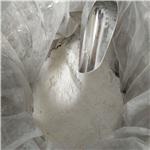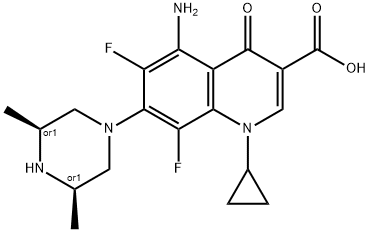- Sparfloxacin
-

- $42.00 / 50mg
-
2024-11-19
- CAS:110871-86-8
- Min. Order:
- Purity: 99.77%
- Supply Ability: 10g
- Sparfloxacin
-

- $42.00 / 50mg
-
2024-11-19
- CAS:110871-86-8
- Min. Order:
- Purity: 99.77%
- Supply Ability: 10g
- Sparfloxacin
-

- $80.00 / 1kg
-
2023-02-13
- CAS:110871-86-8
- Min. Order: 1kg
- Purity: 99%
- Supply Ability: 100MT
Related articles - Side effects of Sparfloxacin
- Sparfloxacin (AT-4140, CI-978, PD 131501) is a newer-generation aminodifluoroquinolone with broad spectrum antibacterial activ....
- Mar 25,2022
|
| | Sparfloxacin Basic information |
| Product Name: | Sparfloxacin | | Synonyms: | Sparfloxacin Solution, 100ppm;Sparfloxacin solution,1000ppm;5-Amino-1-cyclopropyl-6,8-difluoro-1,4-dihydro-7-(3α,5α-dimethyl-1-piperazinyl)-4-oxoquinoline-3-carboxylic acid;5-Amino-1-cyclopropyl-6,8-difluoro-1,4-dihydro-7-(3β,5β-dimethyl-1-piperazinyl)-4-oxoquinoline-3-carboxylic acid;RP-64206;5-Amino-1-cyclopropyl-7-(3,5-dimethyl-1-piperazinyl)-6,8-difluoro-1,4-dihydro-4-oxo-3-quinolinecarboxylic acid;Sparfloxacin;Sparfloxacine | | CAS: | 110871-86-8 | | MF: | C19H22F2N4O3 | | MW: | 392.4 | | EINECS: | 629-019-8 | | Product Categories: | VFEND;Intermediates & Fine Chemicals;Pharmaceuticals;API's;Active Pharmaceutical Ingredients | | Mol File: | 110871-86-8.mol |  |
| | Sparfloxacin Chemical Properties |
| Melting point | 265°C | | Boiling point | 640℃ | | density | 1.436±0.06 g/cm3(Predicted) | | Fp | >110°(230°F) | | storage temp. | Keep in dark place,Inert atmosphere,2-8°C | | solubility | DMF: 10 mg/ml; DMF:PBS(pH 7.2)(1:1): 0.50 mg/ml | | pka | pKa1 6.25, pKa2 9.30(at 25℃) | | form | powder | | color | white to light yellow | | biological source | synthetic | | Water Solubility | Soluble in DMSO at 9mg/ml. Sparingly soluble in water | | BRN | 9170271 | | CAS DataBase Reference | 110871-86-8(CAS DataBase Reference) |
| Hazard Codes | Xi | | Risk Statements | 36/37/38 | | Safety Statements | 26-36 | | WGK Germany | 2 | | RTECS | VB1986500 | | HS Code | 29339900 |
| | Sparfloxacin Usage And Synthesis |
| Description | Sparfloxacin is the most potent fluoroquinolone antibiotic introduced for the treatment
of community acquired infections. It has superior and broad in vitro activity against members
of family Enterobacferiaceae and anaerobic bacteria, some of which are resistant toβ-lactam
antibiotics or to aminoglycosides. In patients with surgical infections, sparfloxacin shows
excellent activity against resistant pathogens. It is effective in treating patients with bladder
irritability and is reported to have potential in the treatment of leprosy and Mycobacterium
tuberculosis in mice. Favorable pharmacokinetic properties, good intracellular penetration and
a lack of transferable resistance have been reported. | | Chemical Properties | Light yellow powder | | Originator | Dainippon (Japan) | | Uses | A fluorianted quinolone antibacterial. | | Uses | antifungal | | Definition | ChEBI: Sparfloxacin is a quinolone, a quinolinemonocarboxylic acid, a N-arylpiperazine, a quinolone antibiotic and a fluoroquinolone antibiotic. | | Manufacturing Process | A mixture of the known compound, ethyl pentafluorobenzoylacetate [J. Org.
Chem., 35, 930 (1970)] (25 g), ethyl orthoformate (20 g), and acetic
anhydride (23 g) was refluxed for 2 h. The reaction mixture was evaporated
to dryness under reduced pressure. The residue was dissolved in diethyl ether
and allowed to react with cyclopropylamine (5.1 g) to give ethyl 2-
pentafluorobenzoyl-3-cyclopropylaminoacrylate (28 g), melting point 89°C.
The ethyl 2-pentafluorobenzoyl-3-cyclopropylaminoacrylate (28 g) was
dissolved in dry tetrahydrofuran and allowed to react with 60% sodium
hydride (3.85 g) at room temperature to give ethyl 1-cyclopropyl-5,6,7,8-
tetrafluoro-1,4-dihydro-4-oxoquinoline-3-carboxylate (18.4 g), melting point
170°-171°C.
A mixture of ethyl 1-cyclopropyl-5,6,7,8-tetrafluoro-1,4-dihydro-4-
oxoquinoline-3-carboxylate (28.2 g), benzylamine (9.8 ml), anhydrous
potassium carbonate (23.6 g), and acetonitrile (140 ml) was heated at 100°-
110°C for 1 h to give ethyl 5-benzylamino-1-cyclopropyl-6,7,8-trifluoro-1,4-
dihydro-4-oxoquinoline-3-carboxylate (21.4 g), which was recrystallized from
ethanol, melting point 134°-135°C.
The ethyl 5-benzylamino-1-cyclopropyl-6,7,8-trifluoro-1,4-dihydro-4-
oxoquinoline-3-carboxylate (20 g) was dissolved in acetic acid (100 ml) and
ethanol (150 ml), and hydrogenolyzed in the presence of 5% palladiumcarbon
(0.5 g) to give ethyl 5-amino-1-cyclopropyl-6,7,8-trifluoro-1,4-dihydro-
4-oxoquinoline-3-carboxylate (14.1 g), which was recrystallized from
chloroform-ethanol, melting point 236°-237°C.
A mixture of the ethyl 5-amino-1-cyclopropyl-6,7,8-trifluoro-1,4-dihydro-4-
oxoquinoline-3-carboxylate (12.6 g), acetic acid (80 ml), water (50 ml), and
concentrated sulfuric acid (9 ml) was heated at 100°-110°C for 40 min to give
5-amino-1-cyclopropyl-6,7,8-trifluoro-1,4-dihydro-4-oxoquinoline-3-carboxylic
acid (11.1 g), which was recrystallized from chloroform-ethanol, melting point
294°-295°C.
A mixture of 5-amino-1-cyclopropyl-6,7,8-trifluoro-1,4-dihydro-4-
oxoquinoline-3-carboxylic acid (1.25 g), cis-2,6-dimethylpiperazine (2.0 g),
and dimethylformamide was stirred at room tempersture for 24 h. The
reaction mixture was evaporated to dryness under reduced pressure and
water was added to the residue. The mixture was extracted with chloroform
and the extract was dried. After evaporation of chloroform, ethanol was added
to the residue. The resulting crystals were filtered and recrystallized from
chloroform-ethanol to give 5-amino-1-cyclopropyl-6,8-difluoro-7-(cis-3,5-
dimethyl-1-piperazinyl)-1,4-dihydro- 4-oxoquinoline-3-carboxylic acid (1.4 g),
melting point: 258°-260°C. | | Brand name | Zagam (Mylan);Spara. | | Therapeutic Function | Antibacterial | | World Health Organization (WHO) | Sparfloxacin is a quinolone antimicrobial agent. See also under
quinolone and fluoroquinolone antimicrobial agents. | | Pharmaceutical Applications | It is highly active against most aerobic Grampositive cocci and Gram-negative bacilli, including fastidious Gram-negative bacilli, Acinetobacter spp., Campylobacter spp. and Legionella spp. Ps. aeruginosa is weakly susceptible. Activity also extends to the genital mycoplasmas, M. tuberculosis and M. avium complex isolates. It is moderately active against some anaerobes (including the B. fragilis group); L. monocytogenes is resistant.
It is well absorbed, achieving a plasma concentration of 1–1.5 mg/L 4.5 h after a 400 mg oral dose. Absorption is decreased in the presence of antacids owing to the formation of chelates with metallic ions. Concentrations in many tissues, including lung, exceed those in plasma. The plasma half-life is 15–20 h. CSF penetration is limited. Around 5–10% of a dose is eliminated unchanged in the urine, with about 30% appearing as the glucuronide. Total clearance is 10–15 L/h. The plasma half-life increases only modestly in renal failure to 30–40 h. About 50–60% of the dose appears as unchanged drug in the feces, mainly as the glucuronide, accounting for 10–20% of the administered dose.
Adverse events are those common to fluoroquinolones, in particular gastrointestinal tract disturbances, CNS effects (mainly headache and insomnia) and rashes. Photosensitivity reactions have been observed in 2–11% of patients. It can prolong the QTc interval and cases of torsade de pointes have been reported. It does not potentiate the toxicity of theophylline.
It has been used for respiratory and other infections caused by susceptible bacteria, but use has been restricted in the USA and Europe because of phototoxicity and cardiotoxicity. | | Clinical Use | Sparfloxacin, (cis)-5-amino-1-cyclopropyl-7-(3,5-dimethyl)-1-piperazinyl)-6,8-difluoro-1,4-dihydro-4-oxo-3-quinolinecarboxylicacid, is a newer fluoroquinolone.
This compound exhibits higher potency against Grampositivebacteria, especially staphylococci and streptococci,than the fluoroquinolones currently marketed. It is also moreactive against chlamydia and the anaerobe Bacteroides fragilis.The activity of sparfloxacin against Gram-negative bacteriais also very impressive, and it compares favorably withciprofloxacin and ofloxacin in potency against Mycoplasmaspp., Legionella spp., Mycobacteria spp., and Listeria monocytogenes.Sparfloxacin has a long elimination half-life of18 hours, which permits once-a-day dosing for most indications.The drug is widely distributed into most fluidsand tissues. Effective concentrations of sparfloxacin areachieved for the treatment of skin and soft tissue infections,lower respiratory infections (including bronchitis and bacterialpneumonias), and pelvic inflammatory disease causedby gonorrhea and chlamydia. Sparfloxacin has also beenrecommended for the treatment of bacterial gastroenteritisand cholecystitis. The oral bioavailability of sparfloxacinis claimed to be good, and sufficient unchanged drug isexcreted to be effective for the treatment of urinary tract infections.Nearly 20% of an orally administered dose is excretedas an inactive glucuronide. |
| | Sparfloxacin Preparation Products And Raw materials |
| Raw materials | Tetrahydrofuran-->Thionyl chloride-->Nitric acid-->Sodium carbonate-->CHLOROETHANE-->Cyclopropylamine-->2,3,4,5-Tetrafluorobenzoic acid-->2,6-Dimethylpiperazine-->3-Quinolinecarboxylic acid, 1-cyclopropyl-5,6,7,8-tetrafluoro-1,4-dihydro-4-oxo-, ethyl ester-->3-Quinolinecarboxylic acid, 1-cyclopropyl-6,7,8-trifluoro-1,4-dihydro-4-oxo-5-[(phenylmethyl)amino]-, ethyl ester-->1-CYCLOPROPYL-5-AMIDO-6,7,8-TRIFLUORO-1,4-DIHYDRO-4-OXO-3- QUINOLINECARBOXYLIC ACID ETHYL ESTER-->5-Amino-l-Cyclopropyl-6,7, 8-Trifluoro-1,4-Dihydro-4-Oxo-3-Quinolinearboxylic Acid |
|